The Moneyball of esports is quite a reality yet. But the Brad Pitt movie and Michael Lewis book has been a good way to describe what Tim Sevenhuysen does as a statistics consultant for League of Legends esports teams.
Sevenhuysen believes that analytics matters when it comes to analyzing and advising professional esports players. And he got a lot of attention last week when Berlin-based esports startup Dojo Madness has launched Shadow.LoL, an analytics and data visualization platform for professional League of Legends teams. Sevenhuysen was a key adviser in helping to create the platform, along with esports outfit Team Liquid.
The Shadows.LoL platform is a software-as-a-service, designed to help pro teams win games, as well as help broadcasters tell more advanced data-driven narratives in their play-by-play “shoutcasts.”
Sevenhuysen, the creator of OraclesElixir.com, is leading the team. He married his background in statistics and research with his love of esports to become a leading voice in the creation and application of LoL analytics. Sevenhuysen provides data to broadcasters, journalists, and coaches around the world, both directly and through his website, and he served as statistical consultant to esports team Fnatic during their 2015 summer EU LCS championship and run to the World Championship semifinal
June 5th: The AI Audit in NYC
Join us next week in NYC to engage with top executive leaders, delving into strategies for auditing AI models to ensure fairness, optimal performance, and ethical compliance across diverse organizations. Secure your attendance for this exclusive invite-only event.
Here’s an edited transcript of our interview.
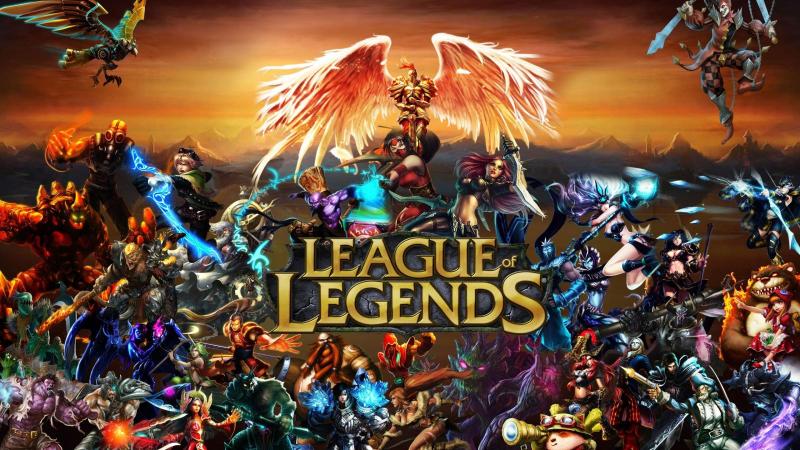
Above: League of Legends is one of the most popular games in the world.
GamesBeat: I was all set to do an interview about the “Moneyball of esports,” but I see from this other article you’re not too fond of that label.
Tim Sevenhuysen: Yeah, I think they’re kind of playing up that angle. I haven’t publicly distanced myself too hard from it, but–
GamesBeat: It’s a place to start, though. Something people can understand.
Sevenhuysen: Yeah, it’s a term people are aware of, especially when the movie came out. Moneyball as a concept was coming up quite a bit, and then they did the movie, so people who hadn’t heard it before all formed associations with it. I guess that’s one reason to avoid it a little bit. It has all these associations, but you want to make your own thing, have your own niche.
GamesBeat: You’re all about statistics, and stats have their place in the League of Legends business. Where would you say it is more useful? With Moneyball the idea was to sign up players before they became famous and expensive.
Sevenhuysen: From what I know of the whole thing, yeah, you’re right. It was about finding value in players that were more valuable than they appeared just by the eye test or whatever. In League of Legends statistics and data have so many different applications, because the nature of League of Legends and almost every esport in general is that the game itself changes very frequently, at a pretty rapid pace.
The game itself receives a new balance update every two weeks, on average. Some of those are big changes and some of them are small. Usually it’s not really huge. Twice a year they’ll make a really big change. But every time that happens the game itself changes in small ways. In a traditional sport, usually the game will get small changes every year, but they’re quite minor. Imagine they changed that every two weeks. Okay, now is there a new strategy we can use to take advantage of this rule?
In hockey, what if they remove the red line and now there’s no such thing as a two line pass? Now you can make big long stretch passes and up your pace. Speedy forwards who can get past the defense on a stretch pass suddenly become much more valuable. If they did that two or three times in mid-season, it becomes valuable to have people who can see those changes and spot the way to exploit them faster than the other teams.
That’s one way you can use data in League of Legends. We’ve seen that the game is changing. How can we measure that change and measure how it affects the best strategies for winning? So that’s one way, just understanding the balance of the game. There’s also using statistics to understand how your opponents play the game and see strengths and weaknesses in their play that you can exploit with strengths and weaknesses in your own team and players. Places you need to improve or places you don’t do very well when you play this style, but you do very well when you play another style.
Then there’s just picking up all kinds of different things about better ways to understand the optimal way to play the game that transition across all the changes in the game itself. There’s a whole range of different methods. Some of them are similar to traditional sports, but some of them are unique to the nature of League of Legends.

Above: Tim Sevenhuysen says that killing heroes isn’t the secret to winning LoL games.
GamesBeat: Did you make some interesting predictions based on stats that helped you gain recognition in the community? How far back does your interest in this go, and how did you build your reputation?
Sevenhuysen: The concept of using stats to make predictions—a lot of people will use that in sports betting or playing daily fantasy or whatever. That was never really my path. One thing that got me, as an individual, recognized in the space was just being an analytical writer. I started my own website, Oracle’s Elixir, about two and a half years ago. I made a certain set of stats available to the public and wrote about them. I’d write articles saying, “Hey, here are the players in the league playing this position. Let’s compare their numbers and talk about them and see what it all means.”
I started becoming more of a writer in the space, writing about players and teams. Sometimes I made predictions as part of that. Who do I think is going to win this game? What are the most likely power rankings? Things like that. That was always an element of my work as a writer. I was writing up until shortly before I joined Shadow. I continue to do a lot of writing. That’s really what gets interest in my website, and my presence as a journalist or an analytical writer.
GamesBeat: How early on did you start seeing the value of analytics here?
Sevenhuysen: It was immediate. It wasn’t just me seeing that value, but other people seeing it as well, people who have a presence as coaches or analysts themselves, working for teams or as broadcasters looking for good storylines to bring on air. Data and stats are often good things to help you on the broadcast. You want to say something about a player, and if you can make a point about a player with numbers to back it up, to support that statement, they’re always looking for that kind of thing, because it’s more compelling.
When I opened up my website and started putting up my articles, I got a great response from people like that – coaches and analysts and broadcasters – approaching me and saying, “Hey, what you’re doing is great. It’s helping us a lot. You have some new ideas.” The response was much bigger than I’d expected, because I didn’t go into it expecting to shake anything up in the scene. It just kind of happened. It generated a lot of momentum.
GamesBeat: And this turned into something valuable as League of Legends grew so much.
Sevenhuysen: Yeah, it was definitely hand in hand. The game itself was quite popular and growing fast. If you can catch that momentum and ride that wave, obviously that’s a great way to find success. I got a little lucky that way. When I started to break in and make a name for myself, that was also when there was a big upsurge in the popularity of League of Legends as an esport. I also got in quite early in the stats movement in general. I like to think I helped build up that stats movement a little bit. I definitely wasn’t the only one, but there was a little first-mover advantage to that.
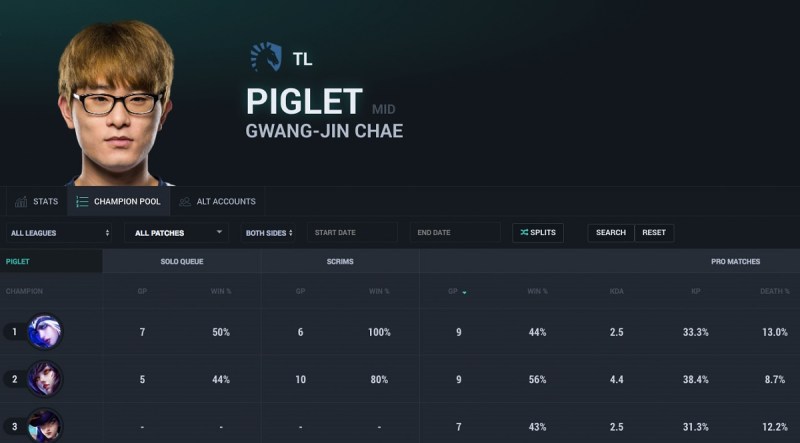
Above: LoL stats in Shadow.gg.
GamesBeat: What are some stats that are valuable to track for teams, especially if you’re trying to rise up over the other consumers playing the game and get to the pro level?
Sevenhuysen: You get the base level stats that everybody knows. On broadcast, or when people play the game themselves, people will talk about certain stats. If you go a layer above those, you start seeing things like—one of the important parts of the game is killing the neutral monsters on the map. You earn gold from that to buy more items. Being more efficient in what they call farming is important, so you’re stronger than the enemy team.
There are ways to measure that. There are only a certain number of monsters to kill, and if you’re killing more than half of them, obviously you’re more efficient. You’re controlling the game better than your opponents. We have some stats about what we call jungle control. There’s also lane control. Those stats measure the same kind of thing for different minions or monsters around the map. Those are very useful to measure—you might be winning the game, but are you winning it efficiently, where you’re in control of the map? Those numbers help to measure that kind of thing. You have to be at the coach level to start applying it, with a good understanding of what it actually means.
GamesBeat: Normally you wouldn’t see this, right? An ordinary player wouldn’t know it or track it.
Sevenhuysen: Yeah, the average viewer probably doesn’t think about that. They tend to think more about things like killing an enemy champion. That’s a really good example, I think, of the difference between the casual viewer and the more analyst-minded viewer, like coaches and broadcasters. The average viewer loves to look at champion kills. You treat it like scoring a goal. On the overlay for a broadcast it’s front and center, because it’s an easy thing to recognize. We’ve killed the enemy team 10 times and they’ve only killed us six times, and so we must be winning.
That’s actually not true. The deeper you understand the game, the more you know that the only real reason to kill the enemy is to buy free time on the map, so you can go take a neutral objective or kill more minions and get stronger that way. The kill is only a means to an end. While the kills are the things that get talked about a lot, and they’re very exciting to watch, they’re less important than a lot of other things we measure.
GamesBeat: Then you got involved with the Shadow project and Dojo Madness. How did that come together for you?
Sevenhuysen: Just through my work and gaining some notoriety in the space, I caught the eye of Jens Hilgers, the CEO, and a few other people that work with him. You’d have to ask him exactly how it came about, but I think he did a bit of digging and learned who I was and my backstory. He reached out to me and said, “We have this company. Here’s some information about what we’re doing. We have this product we’re working on, a couple of things, and we think you’d fit in somewhere.” There wasn’t really a clear vision at that point. He just thought I was an interesting person doing interesting things and maybe we could work together.
As we had a couple of meetings and talked together, we realized that this Shadow project they wanted to build could be a really good fit, because of my involvement in the competitive space and it being a very data-oriented product. I joined up and got involved, started generating the direction of the product, and it’s been really exciting. A lot of big momentum since then.
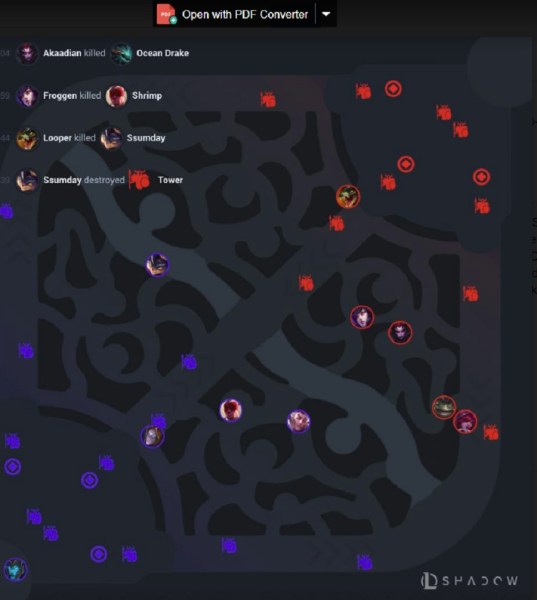
Above: Shadow.LoL provides analytics and visualization for League of Legends teams.
GamesBeat: You narrowed down the number of things to track and the tools to make, then? Is that the process you went through?
Sevenhuysen: There’s always an ongoing process, because there are dozens of different big features we could do. We could make Shadow track these things, or present the data in this way, or help them measure whatever it is. But it’s really important to know that you’re building the most important things first, and you’re building things not only that conceptually make sense for a coach or analyst to use, but also, the details are right. When they come in here they know that these details they see, these specific stats or whatever it is, they’re not just the idea of what’s useful to me. You have to have the details right.
That’s where I’ve spent a lot of my time: trying to make sure it’s really authentic. And not just my own understanding of what should be useful in my mind, but also talking to coaches and analysts, having feedback from people in the space, and showing them something, showing them an outline, and asking, “If we built this, would you use it? How could it be more useful to you?” And then iterating on that as we go, making sure it’s authentic to the space and something that’s useful to a coach or analyst, not just a cool idea that isn’t actually practical.
GamesBeat: As far as the B-to-B nature of the platform, I thought that almost every player would want to know some of these things, and even lots of amateur teams. What’s the distinction here that you think is relevant as far as—is this purely a B-to-B thing that only coaches would be interested in, or is there a B-to-C element here? The story was more popular for us than just a pure B-to-B audience.
Sevenhuysen: There’s always a very interesting balance to strike there. One of the things that’s helped with making Shadow is primarily a B-to-B model. It’s very much about getting a team on board, having multiple people from the same team working together inside our platform, communicating, and sharing information together.
The consumer side—the reason we haven’t built that into Shadow so far is because within Dojo Madness, there is a suite of B-to-C apps as well called the Sumo products. They have something called Lolsumo, which I’m not actively working with, but we consult and share information back and forth with each other. It’s a smart app that helps you gain information about your own play while you’re playing and in between games. It helps you lean about how to improve at the game. Within the Dojo Madness family there’s already a B-to-C app out there that is growing really well.
We want to make sure that the Shadow and Sumo products are in alignment with each other, but we don’t want them to be redundant with each other. Shadow is definitely a B-to-B model. The things we’re exploring a lot—we have the top level professional teams. Here’s what we want to do for them. What about the amateur teams or secondary-level teams? How can we potentially be useful to them? Obviously the economics are going to be different there. The data availability might be different there. We’re actively exploring how to support those different markets and figuring out the best way to approach them.
We don’t want to rush in there. As I was saying before, you want to make sure that what you want to do for that space is authentic to them, and that you’ve tested the market, researched the market there. If we just took a top-level professional team product and offered it to somebody who’s not quite at that level, it maybe doesn’t fit their needs, or you can’t input the same data into it because the ecosystem around the data is different.
There’s a lot of exploratory work to be done. Our core model is B-to-B to a top professional team, but there’s a lot of internal discussion about where to go from there.
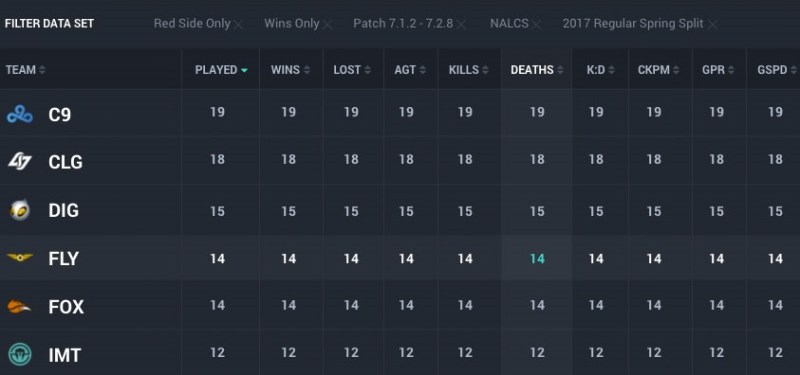
Above: The magic is in the LoL stats.
GamesBeat: In some ways this seems like an old-fashioned expert system, where you’re taking your knowledge and transferring it into an automated product. Do you see it that way, or do you also see something like, “Here’s a tool for the teams, but they probably still have a need for a statistical consultant”?
Sevenhuysen: There are elements of both, for sure. The core thing that is the foundation of Shadow to me is taking a lot of drudgery and grunt work and automating that, so that the experts can be experts. In a lot of cases, what teams will have—even if they have a multi-person staff with a coach and analysts, or even sometimes they have remote analysts working with them in a large team, all of these people are often spending a significant portion of their time just manipulating data or gathering data in the background.
They go into spreadsheets that they build on their own. Every couple weeks they have to build another one. They repeat a lot of work over and over. A lot of their subject matter expertise, or their ability to go in and be an expert, is suppressed by the fact that they have to do all this manual work, taking up half of their work time every week.
We can take that and say, “You used to spend 20 hours a week doing this. Now you spend an hour a week managing it. Our system does the rest. Now use those other 19 hours to actually look at the data and gather insights.” That’s a foundation of what we want to do with Shadow. But we don’t want to just stop there. We also have features, and we’re building a lot more, that open up new ways of looking at data that they just didn’t have before. We have the expertise and the infrastructure to get at data they couldn’t get at themselves. It’s a combination of making them more efficient and enhancing their value as an analyst by adding in brand new features, things they never could have done.
GamesBeat: So you still feel like you have plenty of work to do?
Sevenhuysen: We’re barely scratching the surface.
GamesBeat: As far as results you’re seeing, do you see teams change their behavior because they’re using this?
Sevenhuysen: It’s still fairly early on. This week is our official launch. We’ve just been in beta in the meantime. A lot of that has been information-gathering and user testing. The beta teams that have been working with us on trials or being an actual involved partner—we announced in the press release that Team Liquid was our first client. A team like that has been working with us to make sure that what we’re building is useful to them.
It’s still early to point to that and say, “Hey, look, this team used it for a year and look where they are now.” We’re not at that point yet. But from the internal feedback we get, we’ve definitely seen their staff be more efficient and start to have those benefits of less wasted time on manual work and more time analyzing. You don’t necessarily those results in the team’s results, because it’s behind-the-scenes work. It takes time to build up the momentum and turn that into in-game results. But we’re getting there.
We’re hoping that over the coming six months, 12 months, and longer than that, we’ll have more of those success stories that not only can we point out to coaches and analysts – staff being better at their jobs, which we’re already seeing – but we can also look at the in-game results and how that has translated. It’ll just take more time.

Above: Tim Sevenhuysen holds the next LoL champion.
GamesBeat: As far as players go, do you often see the top player ranks change because the game is changing? It’s often said of Counter-Strike that because the game doesn’t change, the best players can stay on top for a long time, which creates some longevity for celebrities in the game.
Sevenhuysen: There are elements of that, for sure. League of Legends is a much more dynamic game than Counter-Strike in the sense of getting much more frequent balance changes. The absolute best players in the world don’t change that often, though. The number one player in League of Legends for several years has been a player named Faker, who plays in South Korea. Whether he’s head and shoulders above everybody else, or just a head above everybody else, he’s still been the best in the world throughout over a long stretch of time.
In any given week you don’t know how a given player will perform, but when you look at a span of six months or a year, you still have those players who excel above everyone else. But within that notch below them, if you drop the superstars and now you’re just talking about star players, that’s where you see a lot of ranks changing, a lot of cycling. Over this six-month span, here’s the set of 10 star players. The next six months there might be a different set of 10, or five of those 10 have traded out.
But it’s a very hard thing to assess. Opinions change. The leagues they’re playing in change. You have all these regional leagues, and you don’t necessarily see the best players in North America, the best in Korea, the best in Europe—they don’t all play against each other as often as they do in the Counter-Strike model, where you have a lot of international tournaments around the world. It’s a bit hard to say. You have a lot more regional stars, rather than a universally agreed-upon best in the world kind of scenario.
I would say yes, though, that in League of Legends you do get more fluctuation in what players are considered the best at any given point in time. But there’s a decent amount of stability over a period of one, two, three years.
GamesBeat: For a statistician, is League of Legends more fun than other games, like Overwatch?
Sevenhuysen: I think so. From what I know of Overwatch – I’m not super familiar with the game – first of all I don’t think there’s a lot of data available on that game yet. People are still finding the best way to gather the data. But Overwatch is also a much faster-paced game. There’s action happening constantly. That always makes measuring things messier. When I look at Overwatch and think about how I would try to track and measure that game, it gives me a headache. There are ways to do it, but I would need to spend a lot of time in the game.
Other people have already done that, and they’re doing work in the stats space in Overwatch. But you have to be much more embedded in the game to understand, “Okay, what am I measuring that makes sense? What does this number represent, beneath what it seems to represent on the surface?” From a purely numbers standpoint, I think League of Legends is a little easier to measure.
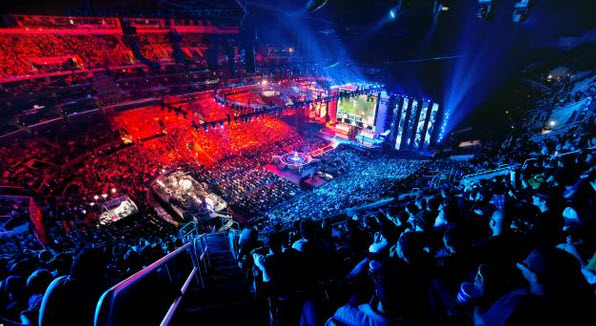
Above: League of Legends finals
GamesBeat: Are you very focused on this game, or do you see yourself popping your head up and looking at other games that might be able to use this technology?
Sevenhuysen: I’m personally very focused on League of Legends. I’m always paying attention to what else is happening, though. People in esports in general are always paying attention to what’s happening in other games, because the success of one esport comes with the success of all esports, really. We’re all in it together, as much as fans of some games may like to go to war with fans of other games that are felt as competitors. At its core, we all know that what’s good for one esport is good for all esports. It generates awareness of competitive video gaming. It generates success and momentum for competitive video gaming as whole.
I haven’t really looked at working on other games personally because, to really understand a game and work on it, you have to play it, and play it for a significant portion of time. Where I’m at, I haven’t been able to do that. But within Dojo Madness we cover a lot of different games and share a lot of knowledge that way. Shadow League of Legends is actually the second Shadow product to launch. We started with Shadow for Counter-Strike, which launched quite a while ago and has been very successful in signing a lot of successful teams who have gotten good value out of it.
This is not the end of Shadow. We’re not going to have two products covering two games and that’s all Shadow ever does. We’re always thinking about when’s the right opportunity to expand and generate more momentum, without stretching ourselves too thin of course.
GamesBeat: Well, thank you very much. Who would have thought you could make a career in League of Legends this way?
Sevenhuysen: Exactly. Somebody has to do it before you know it can be done.


